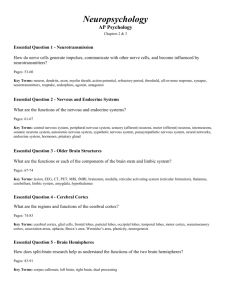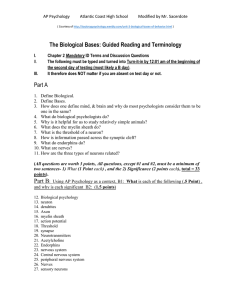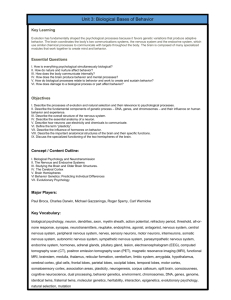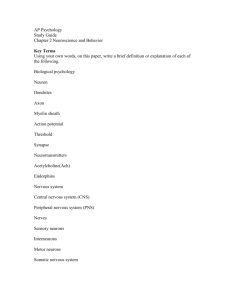Unit II Outline, Vocabulary, and Reading Guide
advertisement
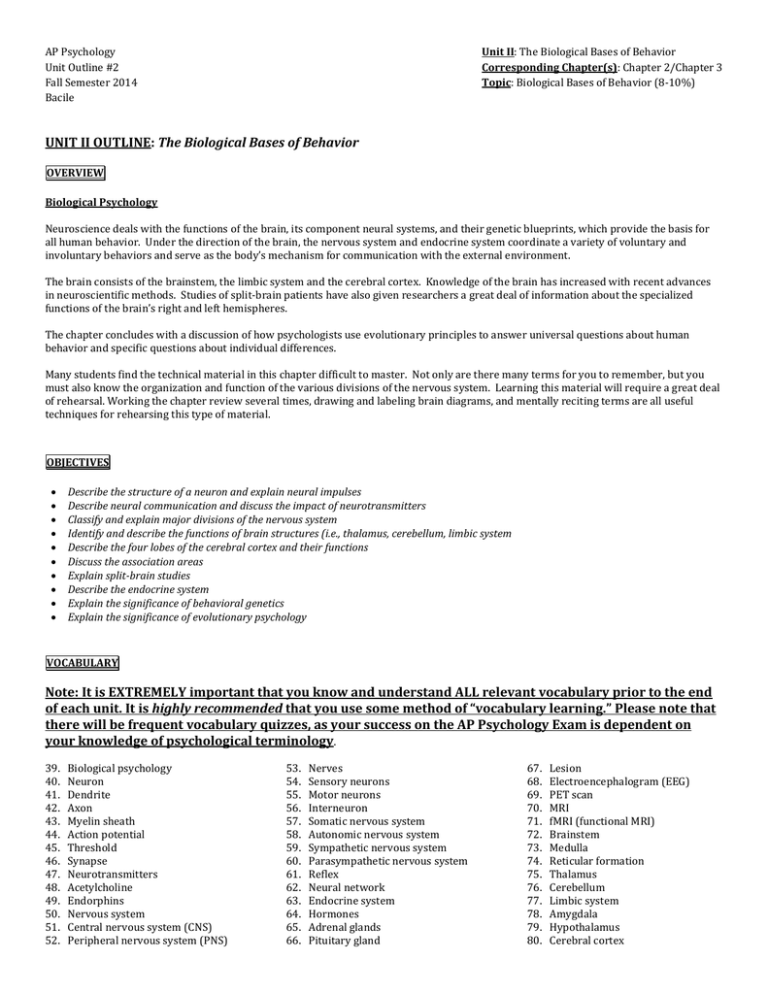
AP Psychology Unit Outline #2 Fall Semester 2014 Bacile Unit II: The Biological Bases of Behavior Corresponding Chapter(s): Chapter 2/Chapter 3 Topic: Biological Bases of Behavior (8-10%) UNIT II OUTLINE: The Biological Bases of Behavior OVERVIEW Biological Psychology Neuroscience deals with the functions of the brain, its component neural systems, and their genetic blueprints, which provide the basis for all human behavior. Under the direction of the brain, the nervous system and endocrine system coordinate a variety of voluntary and involuntary behaviors and serve as the body’s mechanism for communication with the external environment. The brain consists of the brainstem, the limbic system and the cerebral cortex. Knowledge of the brain has increased with recent advances in neuroscientific methods. Studies of split-brain patients have also given researchers a great deal of information about the specialized functions of the brain’s right and left hemispheres. The chapter concludes with a discussion of how psychologists use evolutionary principles to answer universal questions about human behavior and specific questions about individual differences. Many students find the technical material in this chapter difficult to master. Not only are there many terms for you to remember, but you must also know the organization and function of the various divisions of the nervous system. Learning this material will require a great deal of rehearsal. Working the chapter review several times, drawing and labeling brain diagrams, and mentally reciting terms are all useful techniques for rehearsing this type of material. OBJECTIVES Describe the structure of a neuron and explain neural impulses Describe neural communication and discuss the impact of neurotransmitters Classify and explain major divisions of the nervous system Identify and describe the functions of brain structures (i.e., thalamus, cerebellum, limbic system Describe the four lobes of the cerebral cortex and their functions Discuss the association areas Explain split-brain studies Describe the endocrine system Explain the significance of behavioral genetics Explain the significance of evolutionary psychology VOCABULARY Note: It is EXTREMELY important that you know and understand ALL relevant vocabulary prior to the end of each unit. It is highly recommended that you use some method of “vocabulary learning.” Please note that there will be frequent vocabulary quizzes, as your success on the AP Psychology Exam is dependent on your knowledge of psychological terminology. 39. 40. 41. 42. 43. 44. 45. 46. 47. 48. 49. 50. 51. 52. Biological psychology Neuron Dendrite Axon Myelin sheath Action potential Threshold Synapse Neurotransmitters Acetylcholine Endorphins Nervous system Central nervous system (CNS) Peripheral nervous system (PNS) 53. 54. 55. 56. 57. 58. 59. 60. 61. 62. 63. 64. 65. 66. Nerves Sensory neurons Motor neurons Interneuron Somatic nervous system Autonomic nervous system Sympathetic nervous system Parasympathetic nervous system Reflex Neural network Endocrine system Hormones Adrenal glands Pituitary gland 67. 68. 69. 70. 71. 72. 73. 74. 75. 76. 77. 78. 79. 80. Lesion Electroencephalogram (EEG) PET scan MRI fMRI (functional MRI) Brainstem Medulla Reticular formation Thalamus Cerebellum Limbic system Amygdala Hypothalamus Cerebral cortex 81. 82. 83. 84. 85. 86. 87. 88. 89. 90. 91. Glial cells Frontal lobes Parietal lobes Occipital lobes Temporal lobes Motor cortex Sensory cortex Association areas Aphasia Broca’s area Wernicke’s area 92. Plasticity 93. Corpus callosum 94. Split brain 95. Environment 96. Behavior Genetics 97. Chromosomes 98. DNA 99. Genes 100. Genome 101. Identical twins 102. Fraternal twins 103. Temperament 104. Heritability 105. Interaction 106. Molecular genetics 107. Evolutionary psychology 108. Natural selection 109. Mutation 110. Natural selection 111. Gender IMPORTANT FIGURES Joseph Bogen & Philip Vogel Alan Hodgkin & Andrew Huxley READING OUTLINE Directions: In AP Psychology it is ESSENTIAL that you keep up with the reading schedule (please see Unit II: Biological Bases of Psychology Calendar). Please keep in mind that there will be frequent reading quizzes. Chapter TWO (p. 53-93) I. II. NEURAL COMMUNICATION (p. 53-61) a. Neurons b. How Neurons Communicate c. How Neurotransmitters Influence Us THE NERVOUS SYSTEM (p. 61-65) a. The Peripheral Nervous System b. The Central Nervous System III. THE ENDOCRINE SYSTEM (p. 65-67) IV. THE BRAIN (p. 67-93) a. The Tools of Discovery b. Older Brain Structures c. The Cerebral Cortex: Our Divided Brain Chapter THREE (p. 95-113) I. II. BEHAVIOR GENETICS: PREDICTING INDIVIDUAL DIFFERENCES (p. 95-107) a. Genes: Our Code for Life b. Twin Studies c. Adoption Studies d. Temperament Studies e. Heritability f. Gene-Environment Interaction g. The New Frontier: Molecular Genetics EVOLUTIONARY PSYCHOLOGY: UNDERSTANDING HUMAN NATURE (p. 107-113) a. Natural Selection b. An Evolutionary Explanation of Human Sexuality c. Critiquing the Evolutionary Perspective
